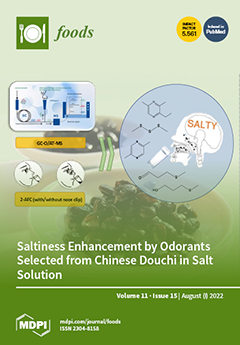The potential of Fourier transform infrared (FT-IR) spectroscopy, multispectral imaging (MSI), and electronic nose (E-nose) was explored in order to determine the microbiological quality of gilthead sea bream (
Sparus aurata) fillets. Fish fillets were maintained at four temperatures (0, 4, 8,
[...] Read more.
The potential of Fourier transform infrared (FT-IR) spectroscopy, multispectral imaging (MSI), and electronic nose (E-nose) was explored in order to determine the microbiological quality of gilthead sea bream (
Sparus aurata) fillets. Fish fillets were maintained at four temperatures (0, 4, 8, and 12 °C) under aerobic conditions and modified atmosphere packaging (MAP) (33% CO
2, 19% O
2, 48% N
2) for up to 330 and 773 h, respectively, for the determination of the population of total viable counts (TVC). In parallel, spectral data were acquired by means of FT-IR and MSI techniques, whereas the volatile profile of the samples was monitored using an E-nose. Thereafter, the collected data were correlated to microbiological counts to estimate the TVC during fish fillet storage. The obtained results demonstrated that the partial least squares regression (PLS-R) models developed on FT-IR data provided satisfactory performance in the estimation of TVC for both aerobic and MAP conditions, with coefficients of determination (R
2) for calibration of 0.98 and 0.94, and root mean squared error of calibration (RMSE
C) values of 0.43 and 0.87 log CFU/g, respectively. However, the performance of the PLS-R models developed on MSI data was less accurate with R
2 values of 0.79 and 0.77, and RMSE
C values of 0.78 and 0.72 for aerobic and MAP storage, respectively. Finally, the least satisfactory performance was observed for the E-nose with the lowest R
2 (0.34 and 0.17) and the highest RMSE
C (1.77 and 1.43 log CFU/g) values for aerobic and MAP conditions, respectively. The results of this work confirm the effectiveness of FT-IR spectroscopy for the rapid evaluation of the microbiological quality of gilthead sea bream fillets.
Full article






